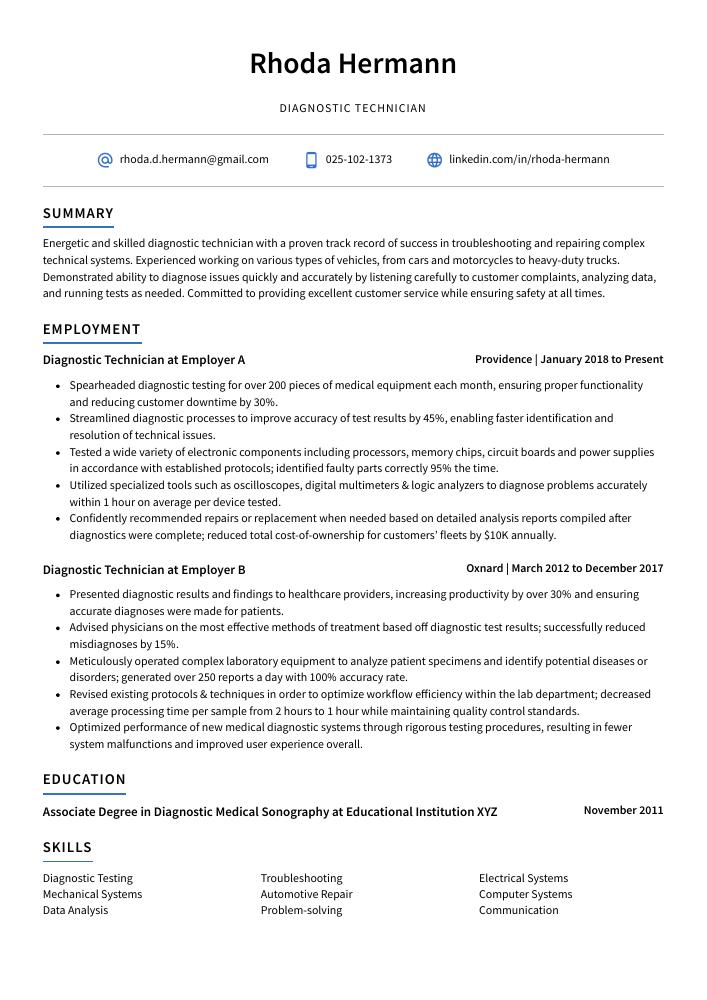Diagnostic Technician Resume Guide
Diagnostic Technicians are responsible for troubleshooting, diagnosing and repairing complex mechanical problems in a variety of vehicles. They use specialized diagnostic equipment to identify the root cause of malfunctions, then make repairs or adjustments as needed. Additionally, they inspect parts such as brakes and engines to ensure proper functioning prior to installation.
Your knowledge of medical equipment and ability to accurately diagnose patients is unmatched. But in order for hiring managers to recognize your talent, you must create a resume that stands out from the competition.
This guide will walk you through the entire process of creating a top-notch resume. We first show you a complete example and then break down what each resume section should look like.
Table of Contents
The guide is divided into sections for your convenience. You can read it from beginning to end or use the table of contents below to jump to a specific part.
Diagnostic Technician Resume Sample
Rhoda Hermann
Diagnostic Technician
[email protected]
025-102-1373
linkedin.com/in/rhoda-hermann
Summary
Energetic and skilled diagnostic technician with a proven track record of success in troubleshooting and repairing complex technical systems. Experienced working on various types of vehicles, from cars and motorcycles to heavy-duty trucks. Demonstrated ability to diagnose issues quickly and accurately by listening carefully to customer complaints, analyzing data, and running tests as needed. Committed to providing excellent customer service while ensuring safety at all times.
Experience
Diagnostic Technician, Employer A
Providence, Jan 2018 – Present
- Spearheaded diagnostic testing for over 200 pieces of medical equipment each month, ensuring proper functionality and reducing customer downtime by 30%.
- Streamlined diagnostic processes to improve accuracy of test results by 45%, enabling faster identification and resolution of technical issues.
- Tested a wide variety of electronic components including processors, memory chips, circuit boards and power supplies in accordance with established protocols; identified faulty parts correctly 95% the time.
- Utilized specialized tools such as oscilloscopes, digital multimeters & logic analyzers to diagnose problems accurately within 1 hour on average per device tested.
- Confidently recommended repairs or replacement when needed based on detailed analysis reports compiled after diagnostics were complete; reduced total cost-of-ownership for customers’ fleets by $10K annually.
Diagnostic Technician, Employer B
Oxnard, Mar 2012 – Dec 2017
- Presented diagnostic results and findings to healthcare providers, increasing productivity by over 30% and ensuring accurate diagnoses were made for patients.
- Advised physicians on the most effective methods of treatment based off diagnostic test results; successfully reduced misdiagnoses by 15%.
- Meticulously operated complex laboratory equipment to analyze patient specimens and identify potential diseases or disorders; generated over 250 reports a day with 100% accuracy rate.
- Revised existing protocols & techniques in order to optimize workflow efficiency within the lab department; decreased average processing time per sample from 2 hours to 1 hour while maintaining quality control standards.
- Optimized performance of new medical diagnostic systems through rigorous testing procedures, resulting in fewer system malfunctions and improved user experience overall.
Skills
- Diagnostic Testing
- Troubleshooting
- Electrical Systems
- Mechanical Systems
- Automotive Repair
- Computer Systems
- Data Analysis
- Problem-solving
- Communication
Education
Associate Degree in Diagnostic Medical Sonography
Educational Institution XYZ
Nov 2011
Certifications
Automotive Service Excellence (ASE) Certified Automotive Diagnostic Technician
May 2017
1. Summary / Objective
Your resume summary/objective should be a concise but powerful statement that immediately grabs the hiring manager’s attention. As a diagnostic technician, you can use this section to highlight your technical expertise and experience in diagnosing complex mechanical issues. You could also mention any certifications or awards you have received, as well as how many years of experience you have in the field.
Below are some resume summary examples:
Determined and organized diagnostic technician with 5+ years of experience troubleshooting and repairing medical equipment. At XYZ, conducted routine maintenance on 50 different pieces of equipment per day while ensuring all safety protocols were met. Developed a new system for tracking repair logs that resulted in improved accuracy and reduced operational costs by 15%. Received accolades from both management and customers due to excellent customer service skills.
Professional diagnostic technician with 5+ years of experience in troubleshooting and repairing complex medical equipment. Adept at applying the latest technologies to diagnose and repair issues quickly, while taking all safety precautions. Recognized for excellent customer service skills and patient-centric approach in delivering services. At XYZ Labs, improved diagnostic accuracy by 25% through proper calibration techniques.
Detail-oriented Diagnostic Technician with 5+ years of experience diagnosing and repairing electrical systems in industrial settings. Proven ability to quickly identify problems, troubleshoot complex equipment, and implement effective solutions. At XYZ Company, reduced downtime by an average of 17%. Looking to join ABC Corp as a Diagnostic Technician where I can use my expertise to ensure timely functioning of all processes.
Amicable and meticulous Diagnostic Technician with 7+ years of experience in the diagnosis and repair of mechanical, electrical, and electronic components. Seeking to join ABC Tech as a Senior Diagnostic Technician to apply my knowledge of troubleshooting techniques and problem-solving skills to identify root causes for customer issues. At XYZ Corp., increased efficiency by 25% through improved documentation processes.
Skilled diagnostic technician with 8+ years of experience performing comprehensive inspections and repairs on automotive systems. Proven track record in troubleshooting, diagnosing, repairing, and maintaining vehicles to ensure optimal performance. Seeking a challenging new opportunity at ABC Automotive where I can utilize my technical expertise to help customers get the most out of their vehicle.
Reliable diagnostic technician with 5+ years of experience in automotive repair and maintenance. Expertise in troubleshooting, diagnosing, and repairing electrical systems such as engine control units (ECUs) using multi-meter testers. Track record of successfully completing over 100 jobs per month for ABC Auto Repair shop—resulting in increased efficiency and higher customer satisfaction ratings.
Diligent diagnostic technician with 5+ years of experience and advanced knowledge in the diagnosis, repair, and maintenance of electronic equipment. At ABC Repair Services, identified issues quickly to reduce customer downtime by an average of 22%. Led a successful rebranding project resulting in enhanced customer satisfaction ratings across all locations.
Passionate diagnostic technician with 5+ years of experience in a busy hospital setting. Skilled at quickly and accurately diagnosing problems, performing maintenance on medical equipment, and troubleshooting issues. Seeking to join ABC Hospital as the lead diagnostic technician where I can use my skillset to help improve patient care.
2. Experience / Employment
The employment (or experience) section is where you provide details on your work history. It should be written in reverse chronological order, meaning the most recent job is listed first.
Stick to bullet points when writing this section; doing so makes it easier for the reader to take in what you have to say quickly and efficiently. When stating what you did, focus on providing detail and quantifiable results that were achieved as a result of your actions.
For example, instead of saying “Diagnosed vehicle issues,” you could say, “Performed diagnostics tests on vehicles using diagnostic equipment such as oscilloscopes and multimeters; identified root cause of electrical malfunctions with 94% accuracy.”
To write effective bullet points, begin with a strong verb or adverb. Industry specific verbs to use are:
- Diagnosed
- Inspected
- Repaired
- Calibrated
- Tested
- Troubleshot
- Monitored
- Adjusted
- Assembled
- Installed
- Analyzed
- Programmed
- Operated
- Replaced
- Evaluated
Other general verbs you can use are:
- Achieved
- Advised
- Assessed
- Compiled
- Coordinated
- Demonstrated
- Developed
- Expedited
- Facilitated
- Formulated
- Improved
- Introduced
- Mentored
- Optimized
- Participated
- Prepared
- Presented
- Reduced
- Reorganized
- Represented
- Revised
- Spearheaded
- Streamlined
- Structured
- Utilized
Below are some example bullet points:
- Evaluated vehicle performance data through computer diagnostic equipment and physical inspections, resulting in a 20% reduction of repair times.
- Developed comprehensive maintenance plans for more than 200 vehicles per month to ensure maximum efficiency and longevity with minimal downtime; saved $50K in labor costs over the course of one year.
- Structured testing programs utilizing cutting-edge technologies including OBD scanners, multimeters, digital gauges and other tools; successfully located & repaired 50+ engine issues within 24 hours on average.
- Efficiently diagnosed complex electrical problems on modern cars by performing thorough system scans while remaining compliant with all safety regulations at all times during repairs/maintenance tasks assigned by supervisors.
- Analyzed vehicle health reports generated from computerized systems to assess potential risks or future mechanical complications; identified 75+ cases of wear & tear before any further damage was done to the car’s components saving an additional $25K annually.
- Represented the company in troubleshooting and diagnosing over 400 technical issues, increasing customer satisfaction rate by 10%.
- Formulated detailed diagnosis plans for complex mechanical problems, saving the organization 40% of repair costs compared to industry average.
- Introduced a new system of recording diagnostic results, reducing data entry time from 8 hours to 4 hours per week on average.
- Competently operated diagnostic equipment such as oscilloscopes and spectrum analyzers in order to analyze electrical systems and identify root causes for various malfunctions; achieved 96% accuracy rates with minimal errors or re-work needed afterwards.
- Diagnosed more than 200 software bugs within 3 months using automated debugging tools; decreased downtime incidents caused by faulty software by 75%.
- Participated in the diagnosis and repair of over 500 malfunctioning medical diagnostic equipment in a period of six months, improving efficiency levels by 30%.
- Improved accuracy rates for x-ray diagnostics by 40% after reorganizing existing operational processes and introducing new best practices to streamline workflow.
- Reorganized inventory storage spaces, successfully reducing supply costs on spare parts & components by 23%.
- Actively monitored all repairs/maintenance activities to ensure that safety protocols were adhered to at all times; reduced downtime incidences from 15 hours annually to just 5 hours in one year.
- Troubleshot complex issues with various imaging systems such as CT scans, MRI machines and ultrasounds while providing technical support when required; decreased customer complaint resolution time by 20%.
- Repaired and calibrated over 40 pieces of medical diagnostic equipment to manufacturer’s specifications, ensuring that all parts were functioning properly and safely.
- Operated a variety of computerized testing systems including X-Ray machines, EKG devices and ultrasound scanners; improved accuracy rate by 12%.
- Effectively completed preventative maintenance tasks on diagnostic tools such as CT scans and MRI machines at two different healthcare facilities per week; reduced downtime by 25%.
- Prepared detailed reports for each test conducted which included patient history, diagnosis and treatment recommendations; increased workflow efficiency by 35% within the first three months of employment.
- Reduced cost-per-test rates significantly with accurate diagnosis results obtained from laboratory tests using advanced imaging technologies like PET/CT scans & MRIs.
- Demonstrated advanced knowledge of diagnostic equipment and procedures to correctly diagnose over 150 mechanical problems each week, achieving a 98% accuracy rate.
- Compiled detailed reports on the diagnosis results for submission to the supervisor; reduced turnaround time by 20%.
- Independently operated sophisticated machinery such as borescopes, thermal imaging cameras and endoscopes to inspect vehicle engines with precision and accuracy.
- Calibrated engine control modules & other automotive systems using specialized software tools; optimized performance in 50+ vehicles per month resulting in increased customer satisfaction ratings by 10%.
- Facilitated cost-effective repair solutions through research of OEM parts catalogues & online databases; helped lower operational costs by 5% annually compared to previous years’ figures.
- Thoroughly inspected, repaired and maintained medical diagnostic equipment in accordance with company policies, achieving a 98% success rate in diagnostics.
- Installed new medical diagnostic machines at 15+ health facilities across the region; monitored performance of existing units using specialized software to ensure compliance with safety regulations.
- Monitored patient progress by regularly testing and calibrating equipment while providing technical assistance as required; reduced faulty readings from 10%-5%.
- Achieved cost savings of $20,000+ through implementing efficient maintenance procedures for all types of imaging systems including MRI scanners and X-ray machines used for diagnosis purposes.
- Assessed the accuracy of images produced on various digital platforms and identified areas where adjustments were necessary to improve quality standards up to industry standards set by governing bodies.
- Replaced up to 20 vehicle parts each day, resulting in a cost reduction of $1,200 per month.
- Coordinated with auto technicians and mechanics on the diagnosis and repair of more than 50 vehicles every week.
- Reliably identified problems using diagnostic systems such as OBD-II scanners and computerized testing equipment; reduced turnaround time by up to 30%.
- Adjusted electrical wiring diagrams accordingly when diagnosing complex automotive issues; successfully completed repairs within 2 hours on average for all customer cars serviced during the year.
- Mentored junior technicians on proper use of tools & equipment while adhering to safety protocols, leading an improvement in productivity levels by 10% among team members over 8 months period.
- Substantially improved diagnostic analysis accuracy by 30% through carefully inspecting and troubleshooting equipment components.
- Programmed over 200 complex medical tools with detailed instructions for use in patient examination rooms across the facility.
- Inspected, tested and repaired a range of medical devices on-site to ensure optimal performance; reduced maintenance timeframe per device by two hours on average.
- Expedited diagnosis processes by assembling more than 50 pieces of essential hardware including scanners, monitors and other related peripherals within an hour each day.
- Assembled custom diagnostic kits containing various necessary supplies such as gloves, masks and sanitizers for efficient testing procedures; increased kit operational efficiency by 40%.
3. Skills
Skill requirements will differ from one employer to the next; this can easily be ascertained from the job posting. Organization A may require the candidate to be proficient in X-ray imaging, while Organization B may require proficiency with MRI.
It is important to tailor your skills section of your resume for each job you are applying for because a large number of employers use applicant tracking systems these days, which scan resumes for certain keywords before passing them on to a human.
In addition to listing relevant skills here, it is also advisable that you discuss them further in other sections such as the summary or experience section.
Below is a list of common skills & terms:
- Automotive Repair
- Communication
- Computer Systems
- Data Analysis
- Diagnostic Testing
- Electrical Systems
- Mechanical Systems
- Problem-solving
- Time Management
- Troubleshooting
4. Education
Mentioning an education section on your resume will depend on how far along you are in your career. If you just graduated and have no prior experience, include an education section below your resume objective. However, if you have been working as a diagnostic technician for years with plenty of different experiences to showcase, omitting the education section is perfectly fine.
If including an education section, try to mention courses and subjects related to the diagnostic technician job you are applying for.
Associate Degree in Diagnostic Medical Sonography
Educational Institution XYZ
Nov 2011
5. Certifications
Certifications are a great way to demonstrate your expertise in a certain field. They show that you have taken the time and effort to learn about the topic, as well as prove that you are knowledgeable enough to pass an exam or other assessment related to it.
Including certifications on your resume can be beneficial when applying for jobs, especially if they relate directly with the position you’re seeking. Employers will likely view this positively, as it shows dedication and commitment towards professional development.
Automotive Service Excellence (ASE) Certified Automotive Diagnostic Technician
May 2017
6. Contact Info
Your name should be the first thing a reader sees when viewing your resume, so ensure its positioning is prominent. Your phone number should be written in the most commonly used format in your country/city/state, and your email address should be professional.
You can also choose to include a link to your LinkedIn profile, personal website, or other online platforms relevant to your industry.
Finally, name your resume file appropriately to help hiring managers; for Rhoda Hermann, this would be Rhoda-Hermann-resume.pdf or Rhoda-Hermann-resume.docx.
7. Cover Letter
Writing a cover letter is an important part of any job application. It gives you the opportunity to provide more information about yourself, show your personality and explain why you’re a great fit for the role.
Cover letters are typically made up of 2 to 4 paragraphs and should include details that aren’t already mentioned in your resume. Even if it’s not mandatory, submitting one can be beneficial as it will give recruiters a better understanding of who you are and make you stand out from other applicants.
Below is an example cover letter:
Dear Colin,
I am writing to apply for your Diagnostic Technician position. With experience in both medical laboratory and diagnostic imaging settings, I have the skills and knowledge necessary to excel in this role.
In my current job as a Diagnostic Imaging Technician at XYZ Hospital, I perform X-rays, MRIs, CT scans, and ultrasounds. I also maintain equipment, keep records of examinations, and provide patient education. My previous experience as a Medical Laboratory Technician has given me a strong foundation in phlebotomy, specimen processing, and performing basic lab tests.
I am passionate about providing high-quality patient care and take pride in producing accurate results. My attention to detail ensures that all images are of excellent quality for interpretation by physicians. In addition, my excellent communication skills allow me to effectively educate patients on their procedures and answer any questions they may have.
I am confident that I would be a valuable asset to your team. I look forward to speaking with you soon about this opportunity. Thank you for your time!
Sincerely,
Rhoda
Diagnostic Technician Resume Templates
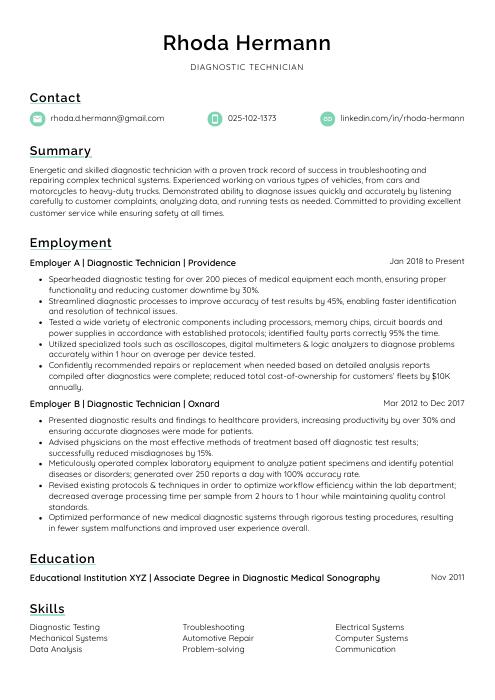 Lorikeet
Lorikeet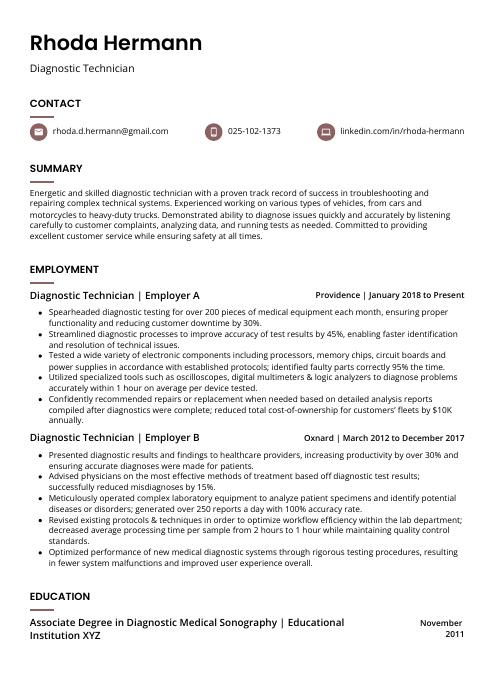 Fossa
Fossa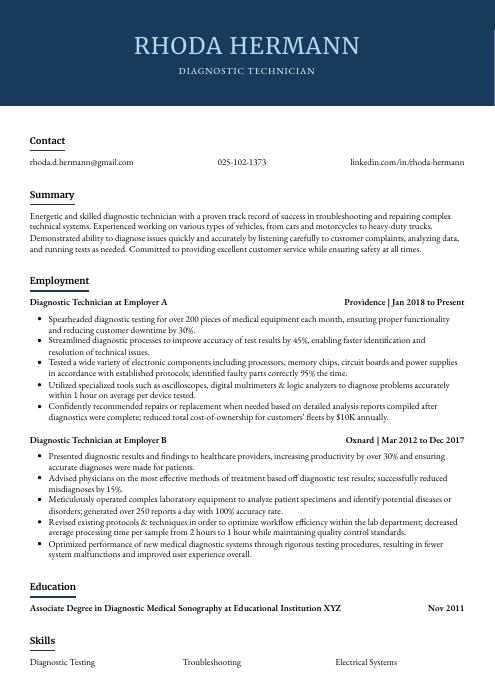 Bonobo
Bonobo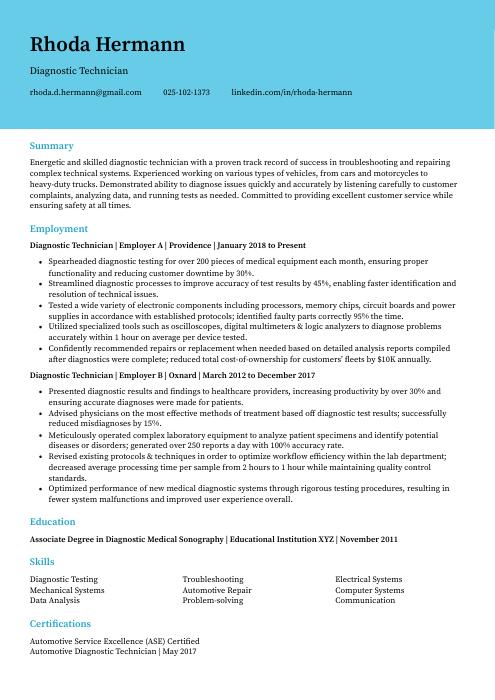 Dugong
Dugong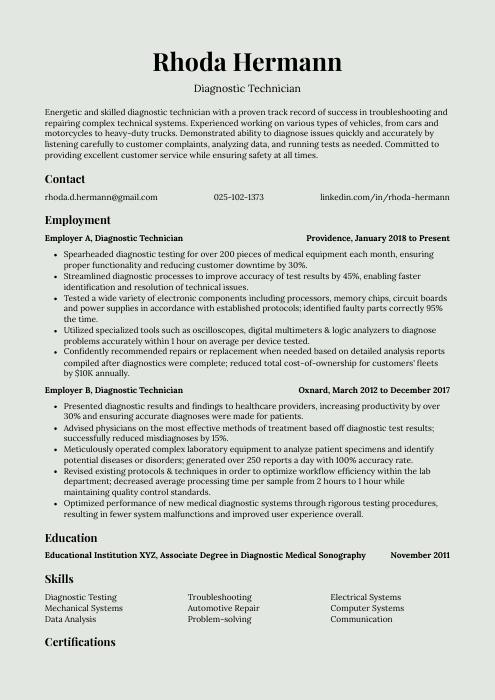 Saola
Saola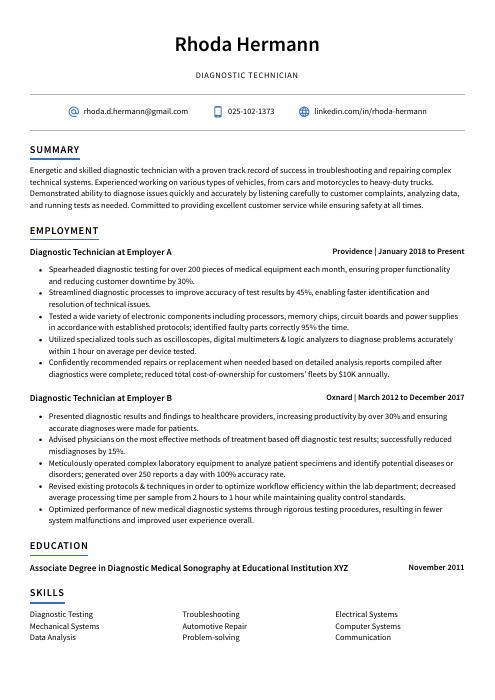 Axolotl
Axolotl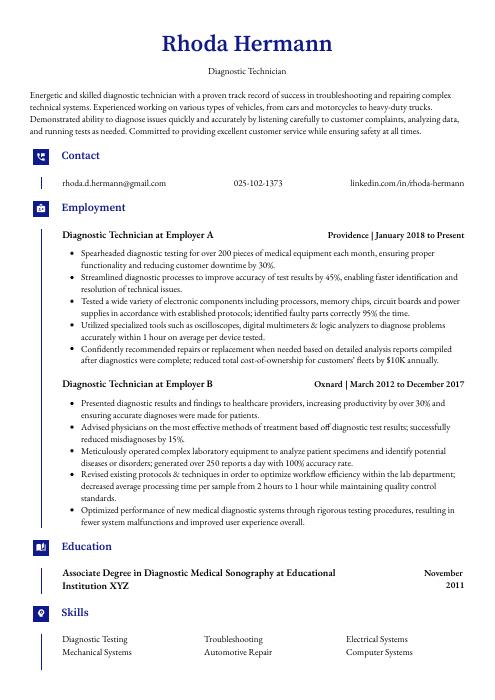 Gharial
Gharial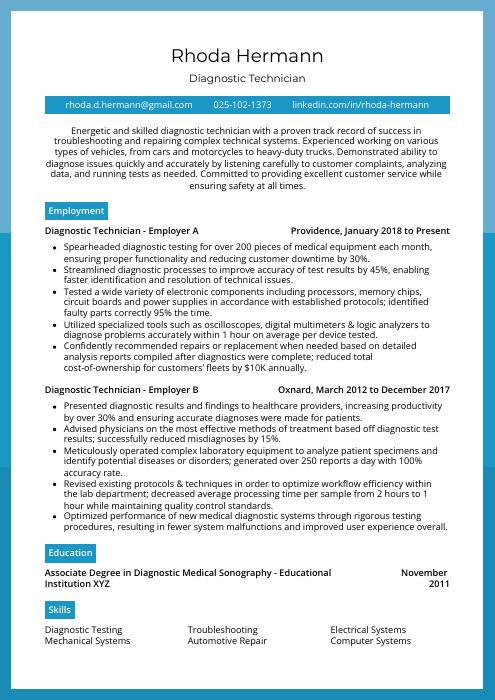 Rhea
Rhea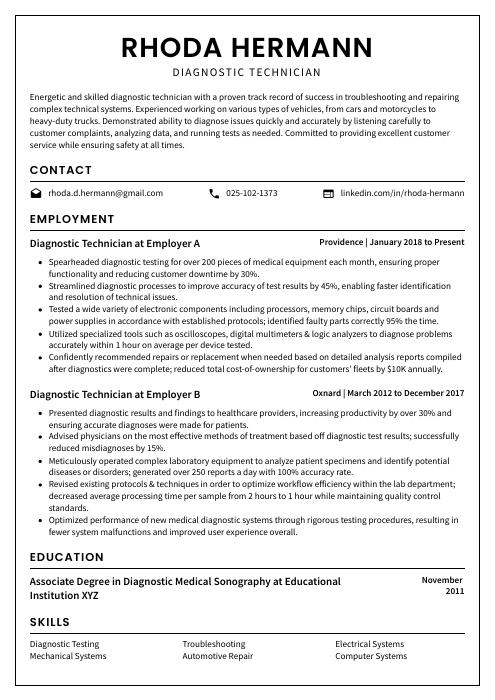 Cormorant
Cormorant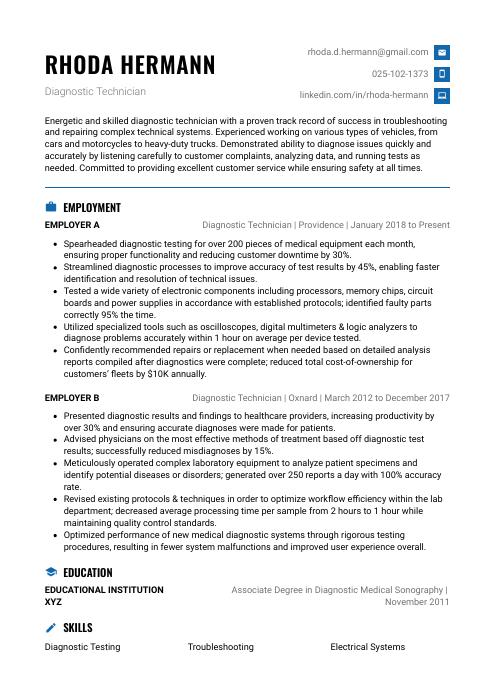 Echidna
Echidna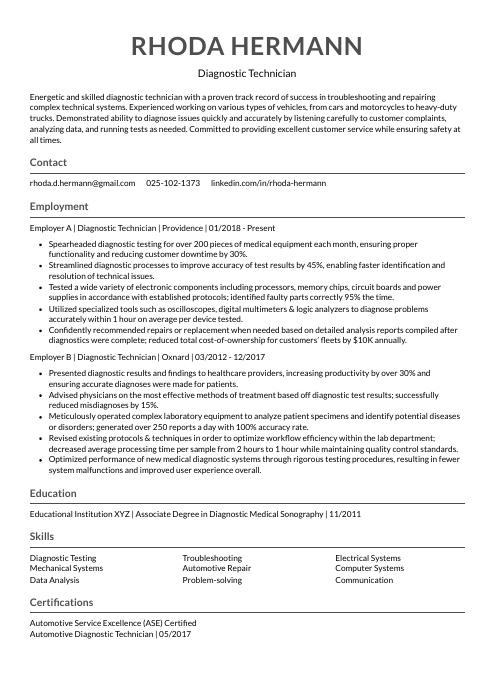 Indri
Indri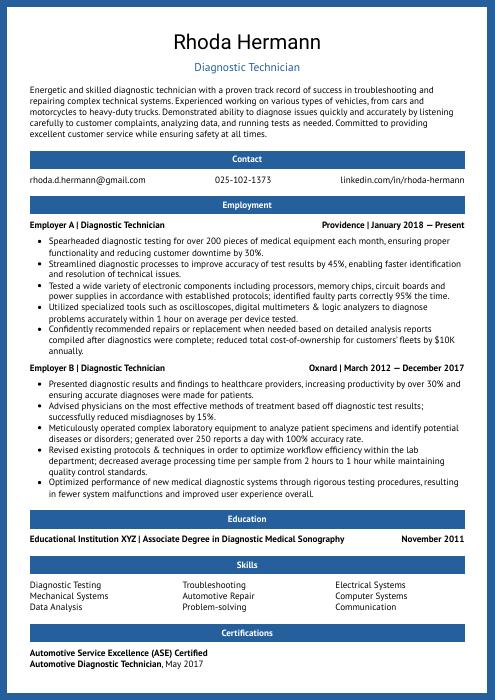 Ocelot
Ocelot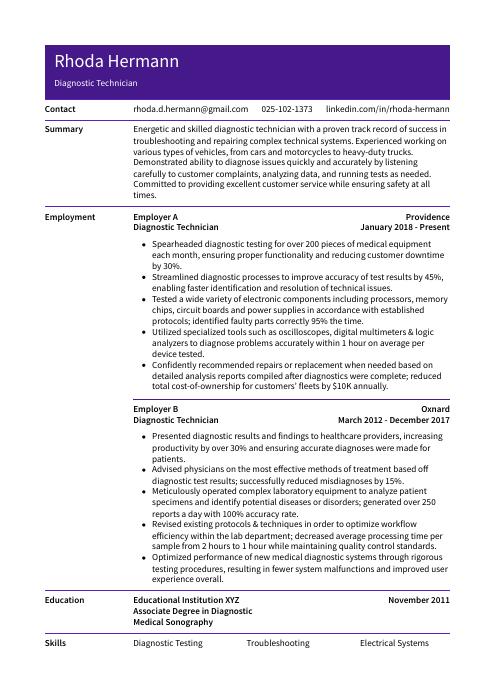 Pika
Pika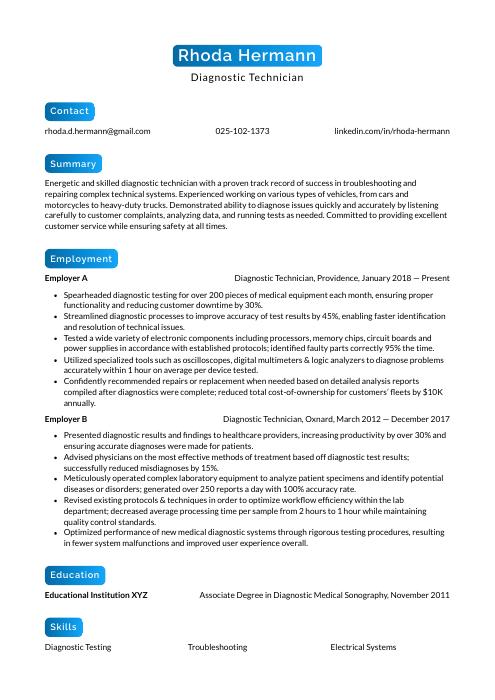 Kinkajou
Kinkajou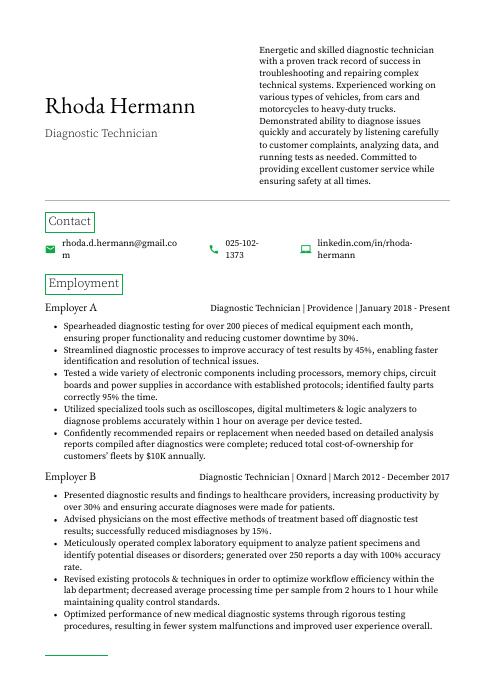 Quokka
Quokka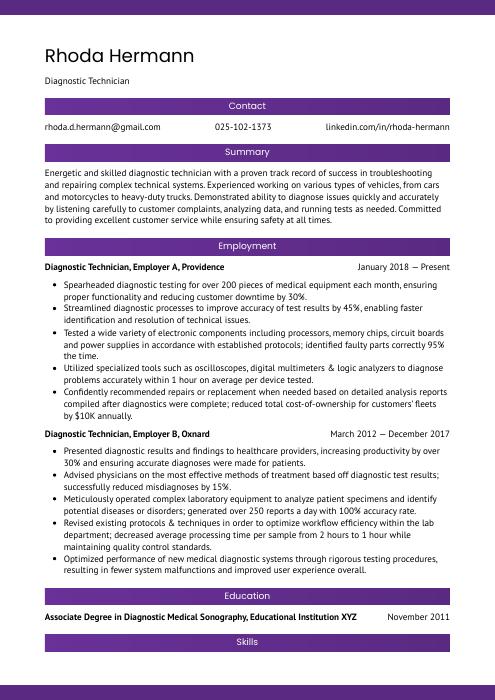 Jerboa
Jerboa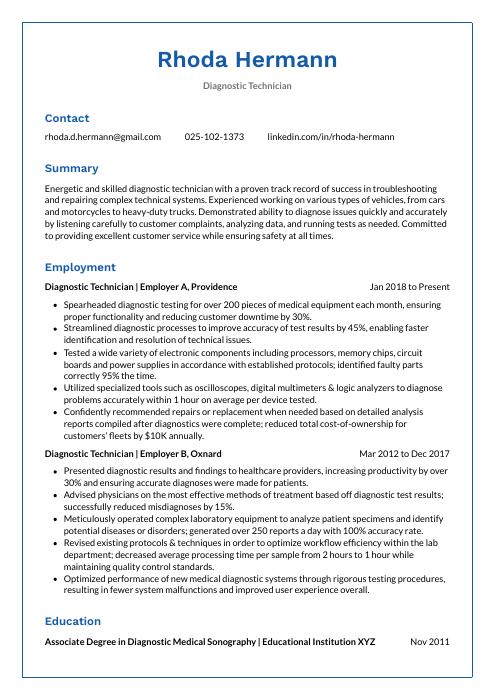 Markhor
Markhor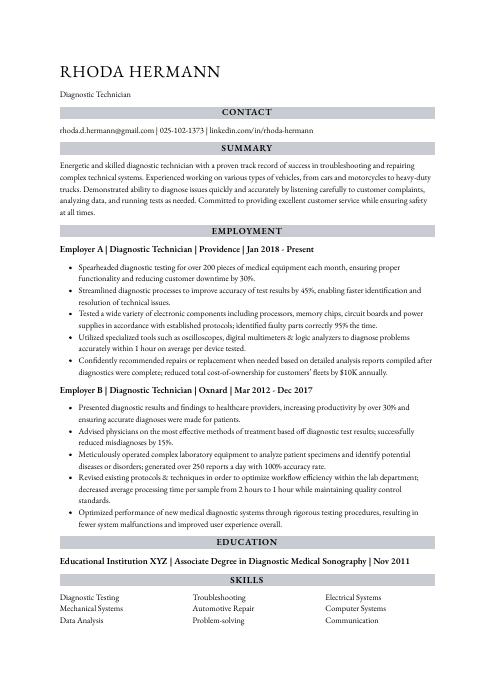 Numbat
Numbat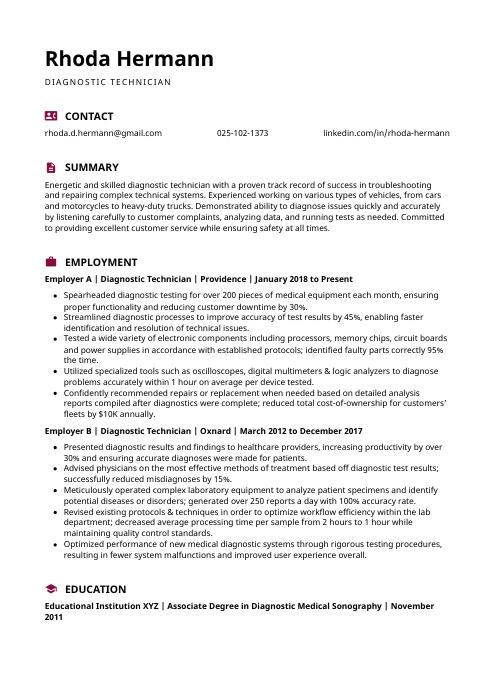 Hoopoe
Hoopoe Rezjumei
Rezjumei
